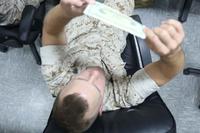The Navy has ships, submarines and aircraft in the North Atlantic this week as the service tests its ability to detect and track undersea vessels in a region where Russian activity has been ramping up.
Exercise Black Widow, which started Saturday and runs through the end of the week, is focused on anti-submarine warfare. The exercise follows several public comments from Navy leaders about increased Russian undersea activity there, posing new challenges in a region they say must be viewed as a contested battlespace.
"This is where the fight is ... where the competition is," Vice Adm. Andrew Lewis, commander of U.S. 2nd Fleet, told reporters Wednesday. "We've got to maintain our positional advantage over the adversary -- specifically in the Atlantic, the undersea capability of the Russians. We have got to maintain that advantage."
Read Next: Former Missile Defense Agency Chief Harassed Female Employee for 7 Years, IG Finds
The amphibious assault ship Wasp; guided-missile destroyers Arleigh Burke and McFaul; two fast attack submarines -- one Virginia class and one Los Angeles class; and patrol aircraft are participating in Black Widow.
The name of the new exercise stems from a submarine tactic that involves breaking a bullseye into quadrants, resembling a spider web. Undersea Warfighting Development Center decided on Black Widow since it’s the most powerful and lethal spider.
Navy leaders declined to say whether they spotted any Russian underwater activity during the exercise. Both the Russians and Chinese have invested heavily in undersea-warfare capabilities, said Vice Adm. Daryl Caudle, commander of Submarine Forces Atlantic.
Russia is fielding some of the most advanced subs in the world -- both fast-attack guided-missile shooters and ballistic-missile shooters, Caudle said.
"That is their capital ship," he said. "... This is a significant issue."
The Russians "took a knee" for more than a decade, Caudle added, leaving many to believe the American homeland was not under threat from the country. That's no longer the case, he said.
"We have to be prepared here to conduct high-end combat operations in local waters just like we do abroad now because of the threats," he said.
Navy leaders have stressed that the service needs to invest heavily in unmanned technologies to better address threats from more tech-savvy and sophisticated adversaries. Lewis declined to answer a question from Military.com about whether the Navy is using unmanned platforms during Black Widow, or if they see a need for them during the exercise.
The Navy is using MH-60R Seahawk helicopters and P-8 Poseidon maritime-patrol and reconnaissance aircraft during the exercise, which Rear Adm. Jim Waters, commander of the newly re-established Submarine Group Two, called "a very lethal combination." Both can see below the waterline -- the Seahawk from lower altitudes and the reconnaissance aircraft from higher up.
Black Widow has been a test in command and control as the Navy has put submarines, ships and aircraft in the region to practice anti-submarine warfare.
"I think this exercise is reflective of the absolute commitment of the Navy -- all communities in the Navy -- to anti-submarine warfare," Waters said.
-- Gina Harkins can be reached at gina.harkins@military.com. Follow her on Twitter @ginaaharkins.
Related: Russian Submarine Activity Has Picked Up in Atlantic, Navy 3-Star Says













